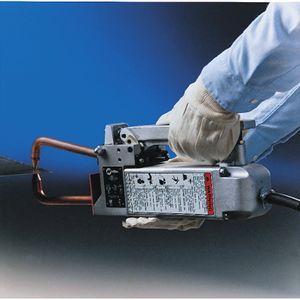Difference between revisions of "Spot Welder"
Jump to navigation
Jump to search
(→Safety) |
|||
| Line 65: | Line 65: | ||
==Safety== | ==Safety== | ||
| − | # | + | # Wear gloves and welding helmet. |
| − | # Don't | + | # Don't have bare skin exposed. |
| − | + | # Don't weld in wet gear or standing water. | |
| − | # Don't weld in wet gear or standing water | + | # Welded material will be hot. |
| − | # | ||
| − | |||
==Certification== | ==Certification== | ||
Revision as of 14:38, 8 May 2020
Make: Miller
Model: LMSW-52
Ace: Levi Gibson (lgibson19@georgefox.edu).
Location: Welding Shop
Resistance spot welding is a process in which contacting metal surface points are joined by the heat obtained from resistance to electric current. The Miller LMSW-52 Air-Cooled Spot Welder is a lightweight unit that is portable, easy to operate and excellent for welding mild, galvanized or stainless materials.
Description
- LMSW-52 spot welder manual [1]
Here is an example of spot welding and some good basic information.
Documentation
Terminology
- Tongs-
Training
Operation
Here are some general setup rules of thumb:
- The maximum weld capacity is 2 sheets of 16 gauge material.
Demonstration
For the demonstration you will need to perform a spot weld.
General Procedure
- Ensure the material being welded should be clear of any oil or dust
- Turn on the spot welder
- Place the material being welded between the clamps.
- Clamp down on the two pieces of material for no more than 5 seconds.
- Grab workpiece with a set of pliers, and open the clamp.
Safety
- Wear gloves and welding helmet.
- Don't have bare skin exposed.
- Don't weld in wet gear or standing water.
- Welded material will be hot.
Certification
Troubleshooting
Maintenance
General maintenance
The welding torch and cables should be inspected on a regular basis. Look for any signs of cracking or cuts in the cables.
Specific Maintenance Tasks
| Maintenance Procedure | Frequency | Done By |
|---|---|---|
| Check Argon Pressure | Before Use | Student/Tech |
| Check Coolant Flow | Before Use | Student/Tech |
| Inspect collet & Cup | Before Use | Student/Tech |
